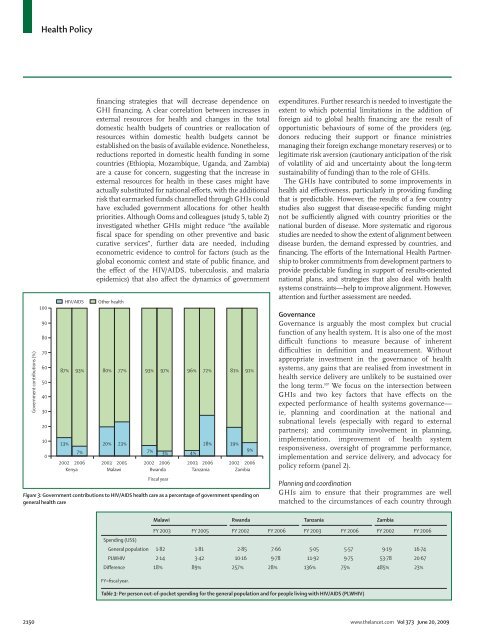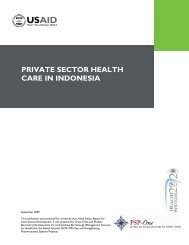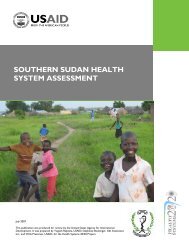An assessment of interactions between global ... - ResearchGate
An assessment of interactions between global ... - ResearchGate
An assessment of interactions between global ... - ResearchGate
Create successful ePaper yourself
Turn your PDF publications into a flip-book with our unique Google optimized e-Paper software.
Health Policy<br />
Government contributions (%)<br />
100<br />
90<br />
80<br />
70<br />
60<br />
50<br />
40<br />
30<br />
20<br />
10<br />
0<br />
87%<br />
HIV/AIDS<br />
financing strategies that will decrease dependence on<br />
GHI financing. A clear correlation <strong>between</strong> increases in<br />
external resources for health and changes in the total<br />
domestic health budgets <strong>of</strong> countries or reallocation <strong>of</strong><br />
resources within domestic health budgets cannot be<br />
established on the basis <strong>of</strong> available evidence. Nonetheless,<br />
reductions reported in domestic health funding in some<br />
countries (Ethiopia, Mozambique, Uganda, and Zambia)<br />
are a cause for concern, suggesting that the increase in<br />
external resources for health in these cases might have<br />
actually substituted for national efforts, with the additional<br />
risk that earmarked funds channelled through GHIs could<br />
have excluded government allocations for other health<br />
priorities. Although Ooms and colleagues (study 5, table 2)<br />
investigated whether GHIs might reduce “the available<br />
fiscal space for spending on other preventive and basic<br />
curative services”, further data are needed, including<br />
econometric evidence to control for factors (such as the<br />
<strong>global</strong> economic context and state <strong>of</strong> public finance, and<br />
the effect <strong>of</strong> the HIV/AIDS, tuberculosis, and malaria<br />
epidemics) that also affect the dynamics <strong>of</strong> government<br />
Other health<br />
93% 80% 77% 93% 97% 96% 72% 81% 91%<br />
13%<br />
20% 23%<br />
28% 19%<br />
7%<br />
7%<br />
3% 4%<br />
9%<br />
2002 2006 2003 2005 2002 2006 2003 2006 2002 2006<br />
Kenya<br />
Malawi<br />
Rwanda<br />
Fiscal year<br />
Tanzania<br />
Zambia<br />
Figure 3: Government contributions to HIV/AIDS health care as a percentage <strong>of</strong> government spending on<br />
general health care<br />
expenditures. Further research is needed to investigate the<br />
extent to which potential limitations in the addition <strong>of</strong><br />
foreign aid to <strong>global</strong> health financing are the result <strong>of</strong><br />
opportunistic behaviours <strong>of</strong> some <strong>of</strong> the providers (eg,<br />
donors reducing their support or finance ministries<br />
managing their foreign exchange monetary reserves) or to<br />
legitimate risk aversion (cautionary anticipation <strong>of</strong> the risk<br />
<strong>of</strong> volatility <strong>of</strong> aid and uncertainty about the long-term<br />
sustainability <strong>of</strong> funding) than to the role <strong>of</strong> GHIs.<br />
The GHIs have contributed to some improvements in<br />
health aid effectiveness, particularly in providing funding<br />
that is predictable. However, the results <strong>of</strong> a few country<br />
studies also suggest that disease-specific funding might<br />
not be sufficiently aligned with country priorities or the<br />
national burden <strong>of</strong> disease. More systematic and rigorous<br />
studies are needed to show the extent <strong>of</strong> alignment <strong>between</strong><br />
disease burden, the demand expressed by countries, and<br />
financing. The efforts <strong>of</strong> the International Health Partnership<br />
to broker commitments from development partners to<br />
provide predictable funding in support <strong>of</strong> results-oriented<br />
national plans, and strategies that also deal with health<br />
systems constraints—help to improve alignment. However,<br />
attention and further <strong>assessment</strong> are needed.<br />
Governance<br />
Governance is arguably the most complex but crucial<br />
function <strong>of</strong> any health system. It is also one <strong>of</strong> the most<br />
difficult functions to measure because <strong>of</strong> inherent<br />
difficulties in definition and measurement. Without<br />
appropriate investment in the governance <strong>of</strong> health<br />
systems, any gains that are realised from investment in<br />
health service delivery are unlikely to be sustained over<br />
the long term. 107 We focus on the intersection <strong>between</strong><br />
GHIs and two key factors that have effects on the<br />
expected performance <strong>of</strong> health systems governance—<br />
ie, planning and coordination at the national and<br />
subnational levels (especially with regard to external<br />
partners); and community involvement in planning,<br />
implementation, improvement <strong>of</strong> health system<br />
responsiveness, oversight <strong>of</strong> programme performance,<br />
implementation and service delivery, and advocacy for<br />
policy reform (panel 2).<br />
Planning and coordination<br />
GHIs aim to ensure that their programmes are well<br />
matched to the circumstances <strong>of</strong> each country through<br />
Malawi Rwanda Tanzania Zambia<br />
FY 2003 FY 2005 FY 2002 FY 2006 FY 2003 FY 2006 FY 2002 FY 2006<br />
Spending (US$)<br />
General population 1·82 1·81 2·85 7·66 5·05 5·57 9·19 16·74<br />
PLWHIV 2·14 3·42 10·16 9·78 11·92 9·75 53·78 20·67<br />
Difference 18% 89% 257% 28% 136% 75% 485% 23%<br />
FY=fiscal year.<br />
Table 3: Per person out-<strong>of</strong>-pocket spending for the general population and for people living with HIV/AIDS (PLWHIV)<br />
2150 www.thelancet.com Vol 373 June 20, 2009
















